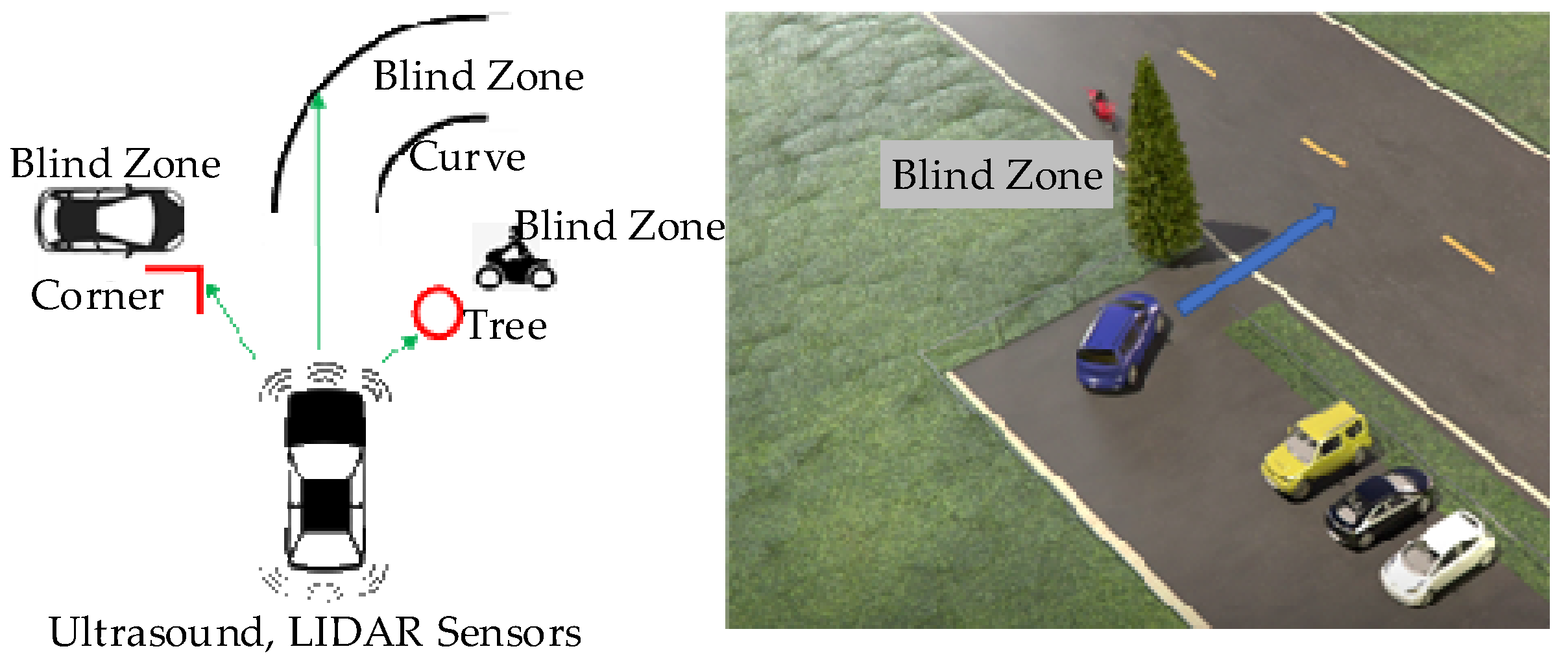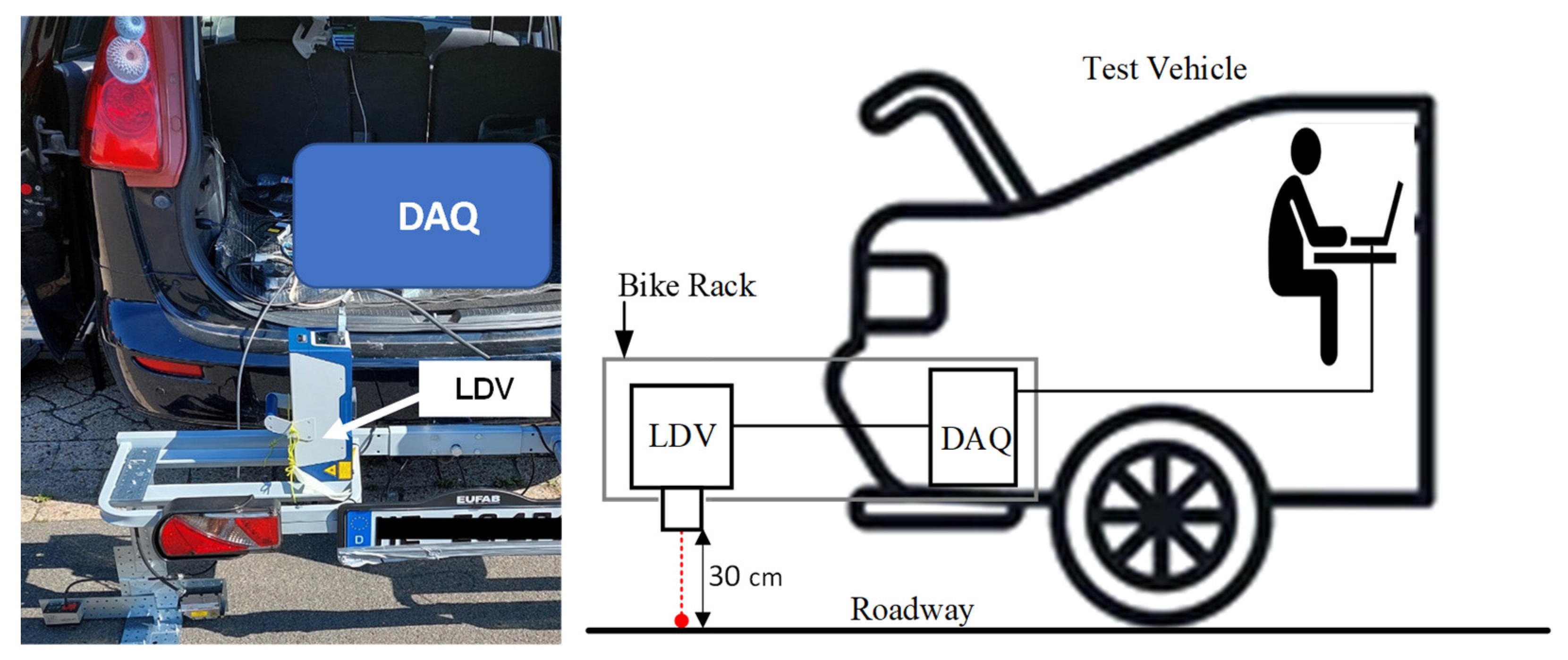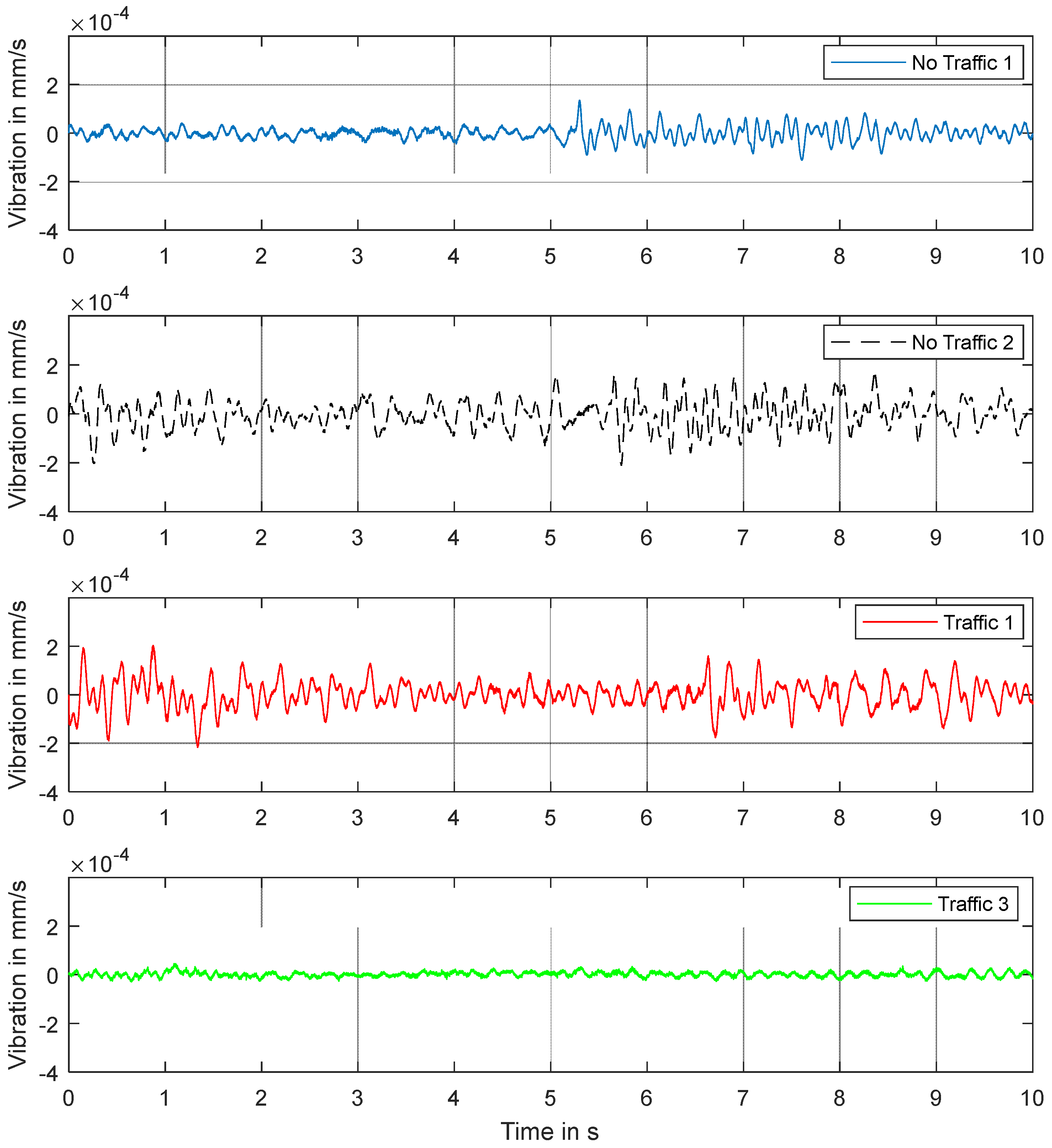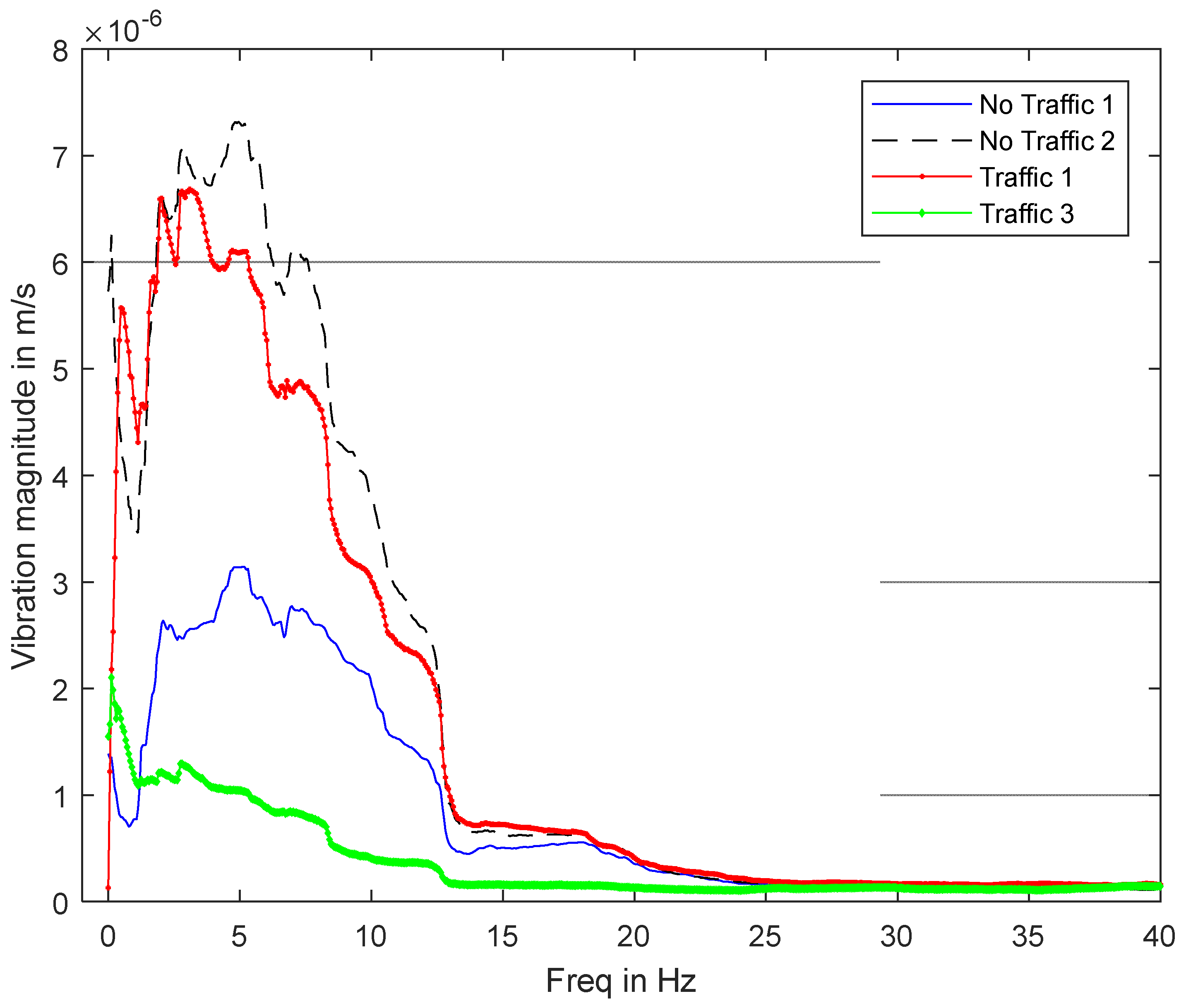Traffic-Induced Vibration Monitoring Using Laser Vibrometry: Preliminary Experiments
Abstract
:1. Introduction
2. Materials and Methods
3. Results and Discussion
3.1. Signal Feature Exploration
3.2. Signal Classification Scheme
4. Conclusions
Author Contributions
Funding
Data Availability Statement
Conflicts of Interest
References
- Unsignalized Intersection Crashes. Available online: https://safety.fhwa.dot.gov/intersection/about (accessed on 20 May 2022).
- Intersection Safety: A Manual for Local Rural Road Owners. Available online: https://safety.fhwa.dot.gov/local_rural/training/fhwasa1108/fhwasa1108.pdf (accessed on 20 May 2022).
- Li, Y.; Ibanez-Guzman, J. Lidar for autonomous driving: The principles, challenges, and trends for automotive lidar and perception systems. IEEE Signal Process. Mag. 2021, 37, 50–61. [Google Scholar] [CrossRef]
- Hayashi, S.; Saho, K.; Isobe, D.; Masugi, M. Pedestrian detection in blind area and motion classification based on rush-out risk using micro-doppler radar. Sensors 2021, 21, 3388. [Google Scholar] [CrossRef] [PubMed]
- Hostettler, R. Traffic counting using measurements of road surface vibrations. M.Sc. Thesis, Luleå University of Technology, Luleå, Seweden, 2009. [Google Scholar]
- Ye, Z.; Wang, L.; Xu, W.; Gao, Z.; Yan, G. Monitoring traffic information with a developed acceleration sensing node. Sensors 2017, 17, 2817–2833. [Google Scholar] [CrossRef] [PubMed] [Green Version]
- Ma, W.; Xing, D.; McKee, A.; Bajwa, R.; Flores, C.; Fuller, B.; Varaiya, P. A wireless accelerometer-based automatic vehicle classification prototype system. IEEE Trans. Intell. Transp. Syst. 2013, 15, 104–111. [Google Scholar] [CrossRef]
- Ling, S.; Yu, F.; Sun, D.; Sun, G.; Xu, L. A comprehensive review of tire-pavement noise: Generation mechanism, measurement methods, and quiet asphalt pavement. J. Clean. Prod. 2021, 287, 125056. [Google Scholar] [CrossRef]
- Ismail, M.A.A.; Mahmod, M.; Rembe, C. Verfahren und Vorrichtung zur Verkehrsüberwachung Mittels Fahrbahnschwingungen und Laservibrometrie. Deutsche Patent DE102020124526, 21 September 2020. [Google Scholar]
- Castellini, P.; Martarelli, M.; Tomasini, E.P. Laser Doppler Vibrometry: Development of advanced solutions answering to technology’s needs. Mech. Syst. Signal Process. 2002, 20, 1265–1285. [Google Scholar] [CrossRef]
- QTec®—Reinventing Vibrometry. Available online: https://www.polytec.com/eu/vibrometry/technology/qtec (accessed on 10 February 2022).
- Sun, L.; Kennedy, T.W. Spectral analysis and parametric study of stochastic pavement loads. J. Eng. Mech. 2002, 128, 318–327. [Google Scholar] [CrossRef]
- Wu, B.; Saxena, A.; Khawaja, T.S.; Patrick, R.; Vachtsevanos, G.; Sparis, P. An approach to fault diagnosis of helicopter planetary gears. In Proceedings of the AUTOTESTCON, San Antonio, TX, USA, 20–23 September 2004; pp. 475–481. [Google Scholar]









| ID | Vehicle | Maximum (×10−4 m/s) | Minimum (×10−4 m/s) | RMS (×10−4 m/s) | Variance (×10−8) |
|---|---|---|---|---|---|
| Traffic 1 | A medium car | 2.03 | −2.17 | 0.56 | 0.32 |
| Traffic 2 | A medium car | 1.40 | −1.74 | 0.32 | 0.10 |
| Traffic 3 | Two medium cars | 0.45 | −0.29 | 0.10 | 0.01 |
| Traffic 4 | A medium car | 2.94 | −2.51 | 1.04 | 1.09 |
| Traffic 5 | A medium car | 1.34 | −1.72 | 0.42 | 0.18 |
| Traffic 6 | Two medium cars | 6.12 | −5.08 | 1.63 | 2.68 |
| Traffic 7 | A medium car | 1.24 | −1.02 | 0.29 | 0.08 |
| Traffic 8 | A heavy car | 1.65 | −1.81 | 0.40 | 0.16 |
| No traffic 1 | - | 1.36 | −1.11 | 0.27 | 0.07 |
| No traffic 2 | - | 1.62 | −2.11 | 0.60 | 0.36 |
| No traffic 3 | - | 3.27 | −3.99 | 0.90 | 0.81 |
| No traffic 4 | - | 0.52 | −0.31 | 0.10 | 0.01 |
| No traffic 5 | - | 2.02 | −2.08 | 0.71 | 0.50 |
| No traffic 6 | - | 1.28 | −1.30 | 0.36 | 0.13 |
| No traffic 7 | 3.21 | −3.81 | 0.86 | 0.74 |
Publisher’s Note: MDPI stays neutral with regard to jurisdictional claims in published maps and institutional affiliations. |
© 2022 by the authors. Licensee MDPI, Basel, Switzerland. This article is an open access article distributed under the terms and conditions of the Creative Commons Attribution (CC BY) license (https://creativecommons.org/licenses/by/4.0/).
Share and Cite
Ismail, M.A.A.; Schewe, M.; Rembe, C.; Mahmod, M.; Kiehn, M. Traffic-Induced Vibration Monitoring Using Laser Vibrometry: Preliminary Experiments. Remote Sens. 2022, 14, 6034. https://doi.org/10.3390/rs14236034
Ismail MAA, Schewe M, Rembe C, Mahmod M, Kiehn M. Traffic-Induced Vibration Monitoring Using Laser Vibrometry: Preliminary Experiments. Remote Sensing. 2022; 14(23):6034. https://doi.org/10.3390/rs14236034
Chicago/Turabian StyleIsmail, Mohamed A. A., Marvin Schewe, Christian Rembe, Mohamed Mahmod, and Michael Kiehn. 2022. "Traffic-Induced Vibration Monitoring Using Laser Vibrometry: Preliminary Experiments" Remote Sensing 14, no. 23: 6034. https://doi.org/10.3390/rs14236034
APA StyleIsmail, M. A. A., Schewe, M., Rembe, C., Mahmod, M., & Kiehn, M. (2022). Traffic-Induced Vibration Monitoring Using Laser Vibrometry: Preliminary Experiments. Remote Sensing, 14(23), 6034. https://doi.org/10.3390/rs14236034






